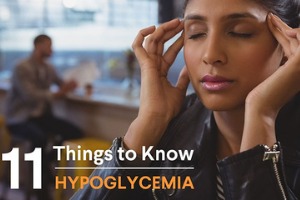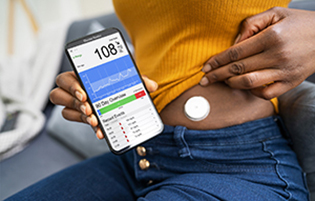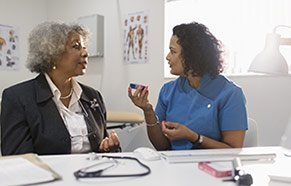Get the Lowdown: What is Hypoglycemia (Low Blood Sugar)?
Low blood sugar, or hypoglycemia, is a potentially dangerous condition that’s most common in people with diabetes. Hypoglycemia occurs when blood sugar levels fall lower than normal and for many people, treatment involves quickly getting your blood sugar back up with high-sugar foods, drinks, or medications. Untreated hypoglycemia can lead to seizures, loss of consciousness and in severe cases even death. That’s why it is important that you, along with your family, friends and coworkers, know the signs of a low blood sugar episode and how to respond quickly.
Could you be at risk?
For people with diabetes, low blood sugar typically occurs when blood sugar levels fall below 70 mg/dl, though this may differ from person to person. Speak with your diabetes care team about your personal blood sugar targets. Other common causes include:
- Taking certain diabetes medications. If you are taking diabetes medications, talk to your clinician to find out how this may affect you.
- Consuming an excessive amount of alcohol.
- Age. Speak with your clinician to find out how this may affect you.
- Having irregular eating habits, such as skipping a meal or eating less than usual (if using a sulfonylurea or insulin).
- Increasing your physical activity without enough nutrition.
If you’ve experienced a low blood sugar emergency, you know how scary it can be. Learn more about the risk and how to handle hypoglycemia here.
Know the signs and symptoms
Part of being prepared for a low blood sugar episode is knowing the signs and symptoms so you can act fast. Typically, these symptoms can range from early and mild, to more severe.
Early, milder symptoms include:
- Nausea and dizziness
- Fast heartbeat
- Sweating and/or chills
- Clamminess
- Unusual irritability or moodiness
Severe symptoms include:
- Blurred or impaired vision
- Coordination problems or clumsiness
- Tingling or numbness in the lips, tongue, or cheeks
- Color draining from the skin
- Seizures
- Confusion
Learn how to recognize and prevent low blood sugar here.
When to see an Endocrinologist
Endocrinologists are specially trained doctors that are qualified to diagnose and treat diabetes and hormone-related diseases and conditions, including hypoglycemia. If you’re experiencing any of the symptoms listed, speak with your health care professional about scheduling an appointment with an endocrinologist in your area.
What to do during a low blood sugar emergency
Talk to your diabetes care team about your blood glucose targets and what treatment options are right for you. Many people with diabetes keep an emergency hypoglycemia rescue kit on hand. This kit could contain candy, juice, sugar or medication such as glucagon (e.g. injected or via nasal spray). Glucagon is available only by prescription and should be discussed with your care team to see if it's an appropriate option for you.
Once you become aware that you are experiencing a low blood sugar emergency, it’s important to know what actions to take.
For Milder Emergencies
Follow the “Rule of 15” by eating 15 grams of carbohydrates or simple sugars, and then rechecking your blood sugar level after 15 minutes. If your blood sugar is still low, consume another 15 grams of carbohydrates and recheck again after 15 minutes. Continue to do this until your blood sugar is at your target level.
To avoid another low, eat a meal or snack when your blood sugar is back to normal.
For Severe Emergencies
Administer emergency hypoglycemia rescue therapy, which contains any delivery method of glucagon (e.g. injected or via nasal spray - available by prescription only). Do not inject insulin, which will lower a person's blood sugar more.
Family and Friends: What Can You Do?
Family and friends should also know the signs and the symptoms of a low blood sugar emergency as well as how to monitor a loved one’s blood sugar levels. It is also helpful for family and friends to have hard candies on hand.
In the event of a severe case of low blood sugar, they should also learn to administer emergency hypoglycemia rescue therapy. If needed, you should take a loved one to the hospital or call for medical assistance immediately.
Hypoglycemia Rescue Kit
Advance preparation is a key defense for chronic disease management during emergencies. Put together an emergency hypoglycemia rescue kit which contains all of the essential items those with diabetes need to have readily available in the event of an emergency. You can create your own kit using My Diabetes Emergency Plan checklist here.
Low blood sugar, or hypoglycemia, causes approximately 100,000 emergency room visits per year in the U.S. Share the lowdown with your friends and family. It can save your life!
Quiz
How much do you know about hypoglycemia? Take our short quiz to see if you are prepared for a hypoglycemic episode here.





